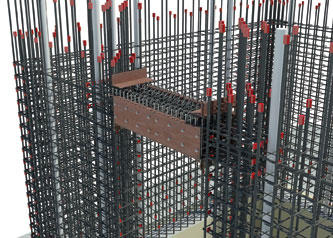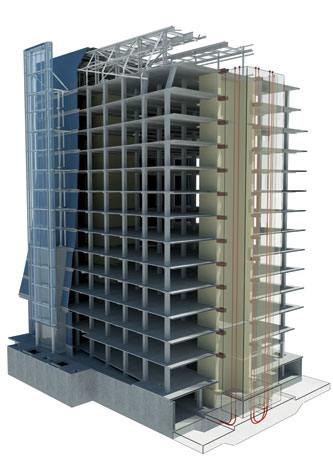Green at Its Core
 |
Horizontal link beams on each level of the core, which act like dampers, have steel plate jackets that serve as formwork during construction. The jackets remain in place after the concrete is poured. Image: courtesy Tipping Mar |
 |
A virtual slice through the building and one of its cores reveals the vertical post-tensioning tendons. During a quake, the unbonded tendons provide a restoring force, closing cracks that develop in the concrete. Image: courtesy Tipping Mar |
Curiously, this level of performance was not the primary motivation for the substitution in structural systems. Instead, the main impetus was the need to cut costs. The moved shaved about $10 million from the construction price, with about half of those savings attributed to the associated elimination of architectural elements, such as fireproofing and finishes, including suspended ceilings. This approach meant that much of the poured-in-place structure would be left exposed, a look that the PUC apparently had no objections to. "You need a client who is able to accept that aesthetic," points out David Hobstetter, KMD principal.
One bonus of the redesigned structural system was that it permitted the team to reduce the floor-to-floor height by a foot and insert an additional office level within the same zoning envelope. But it also provides other synergistic advantages - for the daylighting scheme in particular. The new concrete structure eliminates the sunlight-blocking deep perimeter beams that were a key part of the special moment frame solution. In addition, the new frame allowed designers to taper the underside of floor slabs toward the curtain wall to help bounce the sun's rays from light shelves to the ceiling, and then into the interior of the largely open office floors.
Photo cells control indirect lighting, dimming fixtures when daylight levels are sufficient. To make sure the ceiling's color would be compatible with this illumination strategy, designers set a minimum reflectivity for the concrete in the project's specifications - an unusual request for poured-in-place construction. "We received a lot of RFIs," says Hobstetter.
The PUC has a raised floor for managing data infrastructure and for distributing conditioned air. The system was also included in the steel-framed version of the building, but the cavity provides an added benefit now that the structure is made of concrete. The structure's mass should act like a thermal battery, storing heat generated by people, equipment, and lighting during the day. At night, facility managers should be able to purge this heat by drawing cool outdoor air through the under-floor cavity, helping reduce load on the building's chillers. Unfortunately, because of the limitations of analysis software, engineers weren't able to fully exploit the heat-storing capacity of the structure in their design so that they could, for example, make mechanical equipment smaller. "Modeling tools don't quantify the contribution of thermal mass well," says Ravenscroft. "But we believe there is some benefit."
While the project team tried to make the most of any synergies between the frame and the other building systems, at the same time they worked to reduce the embodied energy typically associated with a concrete structure. To minimize its carbon footprint, engineers have substituted about 70 percent of the Portland cement in a standard concrete mix with supplemental cementitious materials (SCMs), including slag (a byproduct of steelmaking) and fly ash (a byproduct of energy generation from coal-fired power plants). By replacing a material that is energy-intensive to manufacture with waste products that might otherwise have be sent to landfills, team members say that they have cut the carbon emissions of the PUC's concrete in half.
The unusual mix has not been without its challenges, especially for the general contractor, Webcor Builders. Although it already had experience with cement replacement, the PUC structure called for a much higher proportions of SCMs than any of the company's earlier projects. With such a high level of substitution, "the products begin to significantly change the dynamics of hydration," says Matt Rossie, Webcor's project director, referring to the chemical reaction that allows concrete to set and harden when cement is combined with water. In general, SCMs like slag and fly ash slow the process, but understanding just how much is critical to estimating how quickly a particular mixture will gain strength, which in turn is important to both the quality of the finished product and the construction schedule.
To help determine how soon formwork can be stripped and when post-tensioning can be applied Webcor and its subcontractor, San Jose−based Central Concrete Supply, are relying on a process known as "maturity testing." The method involves monitoring the heat generated as a result of hydration with embedded sensors and then correlating those results to laboratory tests for the same mix. "Early strength gain is just a function of temperature and time," explains Mike Donovan, Central's manager of technical services.
Relying on this testing method, contractors have been removing forms from the columns about 24 hours after concrete placement and tensioning the horizontal tendons around three days after each slab pour. At press time in mid-May, the frame was almost complete, with only the tensioning of the core tendons remaining. With all the projects' fits and starts, the contractor is relieved to have reached this milestone. Says Rossie, "It's extremely satisfying to see the structural system come to fruition."








